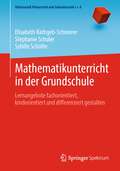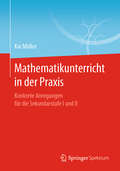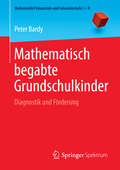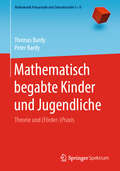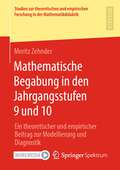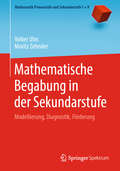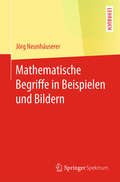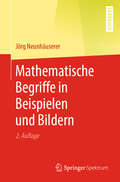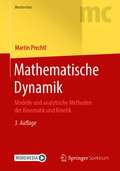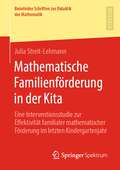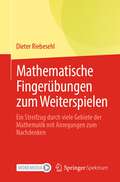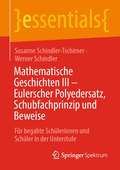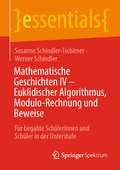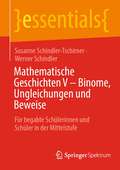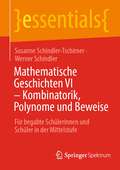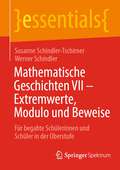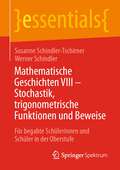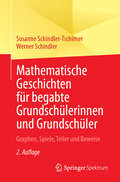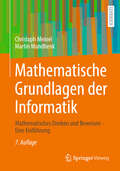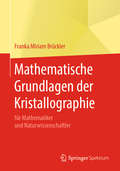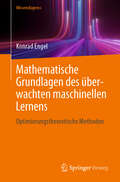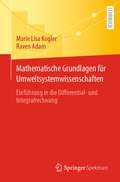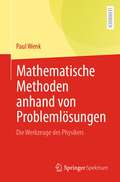- Table View
- List View
Mathematikunterricht in der Grundschule: Lernangebote fachorientiert, kindorientiert und differenziert gestalten (Mathematik Primarstufe und Sekundarstufe I + II)
by Stephanie Schuler Elisabeth Rathgeb-Schnierer Sybille SchütteDieses Buch liefert praktizierenden und zukünftigen Lehrkräften praxistaugliche Anregungen und konkrete Beispiele, wie sie ihren Mathematikunterricht in der Grundschule fachorientiert, kindorientiert und differenziert gestalten können. Die beschriebenen Lernangebote orientieren sich dabei an den drei zentralen Inhalts- und Kompetenzbereichen:Arithmetik (Zahl- und Operationsverständnis, flexibles Rechnen)Geometrie (Begriffsbildung, räumliches Vorstellungsvermögen)Sachrechnen (Förderung von Teilkompetenzen, Modellieren)Die Beispiele werden in einen systematischen Zusammenhang gebracht und die theoretischen Hintergrundannahmen in ihrer praktischen Relevanz dargestellt. Das Buch erläutert daher außerdem, wie und warum eine angemessene Aufgaben-, Unterrichts- und Leistungskultur entwickelt werden kann und sollte.Das Buch fördert und fordert somit letztlich einen maßgeblichen Wandel im Verständnis der Lehrendenrolle: Es gilt, einen Überblick über die Aktivitäten der Kinder zu behalten und sie gezielt zu ermutigen, in ihren eigenen Lösungswegen voranzuschreiten, statt nur als zentrale Wissensinstanz zu fungieren. Das Buch unterstützt somit maßgeblich dabei, die Grundlagen für ein zeitgemäßes Mathematikverständnis zu schaffen, vertiefte inhalts- und prozessbezogene mathematische Kompetenzen aufzubauen und der Herausforderung zunehmend heterogener Lerngruppen gerecht zu werden, ohne die fachlichen Ziele aus den Augen zu verlieren.
Mathematikunterricht in der Praxis: Konkrete Anregungen für die Sekundarstufe I und II
by Kai MüllerDieses Buch schlägt eine Brücke zwischen Fachdidaktik und Unterrichtspraxis der Mathematik: Referendare, Lehramtsstudierende und Lehrende der Sekundarstufe I und II finden hier konkrete Anregungen und Beispiele für Ihren eigenen Unterricht, die in der Praxis erprobt sind. Die Kapitel sind auch unabhängig voneinander lesbar – das Buch lädt daher sowohl zur gezielten Suche nach Unterrichtsbeispielen als auch zum Schmökern und Entwickeln eigener Ideen ein. Die Anordnung der Kapitel spiegelt die übliche Reihenfolge bei der Unterrichtsplanung wider. Die einzelnen Anregungen sind jeweils kompakt und übersichtlich gestaltet: Sie stellen das Fachliche in den Vordergrund, um zu zeigen, wie sich daraus Didaktik und Methodik ergeben. Thematisch werden alle fünf Leitideen der Bildungsstandards aufgegriffen: Algorithmus und Zahl, Messen, Raum und Form, funktionaler Zusammenhang, Daten und Zufall. Der Autor Kai Müller ist Diplomphysiker mit Schwerpunkt theoretische Physik und Mathematik. Er hat sich vor allem der fachdidaktischen Ausbildung von Referendaren verschrieben – zunächst als Gymnasial-Lehrer und seit einigen Jahren zusätzlich als Lehrbeauftragter an der Universität Heidelberg sowie dem Seminar für Ausbildung und Fortbildung der Lehrkräfte (Gymnasium). Stimmen zum Buch Das Buch zeigt anschaulich an exemplarisch dargestellten Unterrichtsstunden, wie sich guter Unterricht machen lässt. Es überbrückt die Kluft zwischen Theorie und Praxis […] nicht in Form abgehobener theoretischer Analysen, vielmehr liefert es jenen, die vor den Klassen stehen, attraktive und erprobte Bausteine für die Gestaltung einer Unterrichtsstunde. Prof. Dr. Christian Hesse, Universität Stuttgart
Mathematisch begabte Grundschulkinder: Diagnostik und Förderung (Mathematik Primarstufe und Sekundarstufe I + II)
by Peter BardyNach den Diskussionen über das Abschneiden deutscher Schülerinnen und Schüler in internationalen Vergleichsstudien (TIMMS,PISA,IGLU-E) haben auch die Diagnose und die Förderung begabter Kinder mittlerweile bei uns zunehmend öffentliche Aufmerksamkeit gefunden. Die Probleme mathematisch begabter Grundschulkinder und ihre spezifischen Bedürfnisse sind aber bisher nur wenig bekannt geworden. Hier besteht ein erheblicher Nachholbedarf in der Aus-, Fort- und Weiterbildung von Grundschullehrerinnen und -lehrern. Das vorliegende Buch informiert Sie ausführlich über: - Erfahrungen mit mathematisch begabten Grundschulkindern (einschließlich einiger Fallstudien) - Begabungsmodelle - das Phänomen "mathematische Begabung" - die Diagnose mathematischer Begabung im Grundschulalter - Ziele und Organisationsformen der Förderung - Schwerpunkte der Förderung: Verwendung heuristischer Hilfsmittel, allgemeine Strategien des Lösens mathematischer Probleme, logisches/schlussfolgerndes Denken, Argumentieren/Begründen/Beweisen, Strukturen erkennen, Verallgemeinern/Abstrahieren, Kreativität, selbstständiges Erweitern/Variieren von Problemstellungen, räumliches Vorstellungsvermögen - zahlreiche geeignete Aufgabenformate mit Eigenproduktionen von Kindern - ergiebige mathematische Themenfelder Das Buch wendet sich an Studierende des Lehramts an Grundschulen, an Lehramtsanwärterinnen und -anwärter, an Lehrkräfte sowie an Eltern.
Mathematisch begabte Kinder und Jugendliche: Theorie und (Förder-)Praxis (Mathematik Primarstufe und Sekundarstufe I + II)
by Thomas Bardy Peter BardySchon länger ist bekannt, dass auch die Entwicklung begabter Kinder und Jugendlicher nicht von allein verläuft, sondern vielfältiger Unterstützung vor allem durch Elternhaus und Schule bedarf. Die Förderung interessierter und begabter Mädchen und Jungen ist deshalb eine wichtige Aufgabe der Schule vom ersten Schultag an. Dies gilt selbstverständlich auch für die Mathematik. Mit dem geplanten Buch sollen aktuelle theoretische Grundlagen zum Themenkreis „mathematische Begabung“ zur Verfügung gestellt werden. Diese umfassen zunächst eine Einführung in Theorien und Modelle zum (allgemeinen) Begabungsbegriff und Beziehungen zum Konstrukt „Intelligenz“. Schwerpunkt sind Konzepte zum Konstrukt „mathematische Begabung“ in Grundschule und Sekundarstufe I. Wichtig ist den Autoren, dass Begabungsmerkmale dabei an geeigneten mathematischen Problemstellungen (die Leserinnen und Leser zunächst auch selbst bearbeiten können) und authentischen Schülerprodukten erläutert werden. Außerdem werden auch Facetten wie „neurowissenschaftliche Grundlagen mathematischer Begabung“ oder „mathematisch begabte Mädchen“ beleuchtet.
Mathematische Begabung in den Jahrgangsstufen 9 und 10: Ein theoretischer und empirischer Beitrag zur Modellierung und Diagnostik (Studien zur theoretischen und empirischen Forschung in der Mathematikdidaktik)
by Moritz ZehnderInternationale Vergleichsstudien deuten darauf hin, dass eine Förderung mathematisch besonders begabter Schüler*innen nicht immer optimal gelingt; eine mögliche Ursache dafür können Schwierigkeiten bei ihrer Identifikation sein. Moritz Zehnder untersucht in der vorliegenden Arbeit daher, welche mathematischen Fähigkeiten Indikatoren für eine besondere mathematische Begabung in den Jahrgangsstufen 9 und 10 darstellen. Im Anschluss an eine Klärung des Begabungsbegriffs leitet er fünf potenziell auf eine besondere mathematische Begabung hinweisende Fähigkeiten ab, deren Eignung als Indikatoren im Rahmen einer nicht experimentellen Studie untersucht wird. Die Ergebnisse zeigen, dass unter anderem dem Erkennen von Mustern und Strukturen eine besondere Bedeutung für eine mathematische Begabung in den Jahrgangsstufen 9 und 10 zukommt. Andere Fähigkeiten, wie etwa mathematische Kreativität, ermöglichen lediglich eine Unterscheidung von Begabungstypen. Ein weiteres zentrales Ergebnis dieser Arbeit ist ein Diagnoseinstrument für mathematische Begabung, das Mathematiklehrkräfte beim Diagnostizieren mathematisch begabter Schüler*innen unterstützen kann.
Mathematische Begabung in der Sekundarstufe: Modellierung, Diagnostik, Förderung (Mathematik Primarstufe und Sekundarstufe I + II)
by Volker Ulm Moritz ZehnderDas Buch widmet sich grundlegenden Fragen zu mathematischer Begabung mit Fokus auf Schülerinnen und Schüler der Sekundarstufen I und II. Der Begabungsbegriff wird perspektivenreich mit Bezug zum Fach Mathematik beleuchtet. Es werden praxiserprobte Konzepte zur Diagnostik mathematischer Begabung und zur Förderung mathematisch besonders begabter Schülerinnen und Schüler vorgestellt. Dabei steht insbesondere der reguläre, alltägliche Mathematikunterricht im Blickfeld. Er wird als primärer Ort für Begabungsförderung gesehen. Zudem werden Anregungen gegeben, wie an Schulen Mathematikunterricht systematisch hin zu bewusst begabungsförderndem Unterricht weiterentwickelt werden kann. Damit richtet sich das Buch an Lehramtsstudierende des Faches Mathematik, Lehrende an Hochschulen im Bereich Mathematikdidaktik sowie Mathematiklehrkräfte an Schulen der Sekundarstufen.
Mathematische Begriffe in Beispielen und Bildern
by Jörg NeunhäusererDieses Buch ist ein wichtiges studienbegleitendes Hilfsmittel für alle die Mathematik-Lehrveranstaltungen besuchen. Die Lektüre dieses Buch ermöglicht Ihnen, begriffliche Sicherheit für Mathematik-Vorlesungen und Prüfungen aufzubauen. Die Lektüre jedes Kapitel dieses Buches erlaubt Ihnen, einen Überblick über die Begriffe eines Teilgebiets der Mathematik zu erhalten und diese Begriffe nachhaltig zu erfassen. Wenn Sie als Student einen mathematischen Begriff nicht richtig verstehen oder sich an seine Definition nicht erinnern, können Sie in diesem Buch nachschlagen und erhalten durch paradigmatische Beispiele und Bilder ein fundiertes Verständnis des Begriffs. Arbeiten Sie ein Kapitel dieses Buches in Vorbereitung einer Prüfung durch, so können Sie sich in begrifflicher Hinsicht in der Prüfung sicher fühlen. Insgesamt finden sich in diesem Buch mehr als tausend Definitionen von Begriffen aus vierzehn Teilgebieten der Mathematik. Die Auswahl der Begriffe orientiert sich in jedem Kapitel an den Vorlesungen zum behandelten Thema, die an deutschen Hochschulen gehalten werden. Alle wesentlichen Begriffe, die in Mathematik-Vorlesungen in Bachelorstudiengängen vorkommen und auch alle grundlegenden Begriffe der Mathematik-Vorlesungen in Masterstudiengängen sind in diesem Buch enthalten. Dieses Buch stellt also einen Kanon mathematischer Begriffe vor, der auch für Lehrende von Interesse ist.
Mathematische Begriffe in Beispielen und Bildern
by Jörg NeunhäusererDieses Buch ist ein wichtiges studienbegleitendes Hilfsmittel für alle, die Mathematik-Lehrveranstaltungen besuchen. Die Lektüre dieses Buch ermöglicht Ihnen, begriffliche Sicherheit für Mathematik-Vorlesungen und Prüfungen aufzubauen. Die Lektüre jedes Kapitel dieses Buches erlaubt Ihnen, einen Überblick über die Begriffe eines Teilgebiets der Mathematik zu erhalten und diese Begriffe nachhaltig zu erfassen. Wenn Sie als Student einen mathematischen Begriff nicht richtig verstehen oder sich an seine Definition nicht erinnern, können Sie in diesem Buch nachschlagen und erhalten durch paradigmatische Beispiele und Bilder ein fundiertes Verständnis des Begriffs. Arbeiten Sie ein Kapitel dieses Buches in Vorbereitung einer Prüfung durch, so können Sie sich in begrifflicher Hinsicht in der Prüfung sicher fühlen. Insgesamt finden sich in diesem Buch mehr als tausend Definitionen von Begriffen aus vierzehn Teilgebieten der Mathematik. Die Auswahl der Begriffe orientiert sich in jedem Kapitel an den Vorlesungen zum behandelten Thema, die an deutschen Hochschulen gehalten werden. Alle wesentlichen Begriffe, die in Mathematik-Vorlesungen in Bachelorstudiengängen vorkommen und auch alle grundlegenden Begriffe der Mathematik-Vorlesungen in Masterstudiengängen sind in diesem Buch enthalten. Dieses Buch stellt also einen Kanon mathematischer Begriffe vor, der auch für Lehrende von Interesse ist. Die 2. Auflage ist vollständig durchgesehen und um acht neue Abschnitte zu weiterführenden Themen wie etwa Simplizialkomplexen und Homologiegruppen sowie Differenzialformen erweitert.
Mathematische Dynamik: Modelle und analytische Methoden der Kinematik und Kinetik (Masterclass)
by Martin PrechtlIn diesem Lehrbuch werden folgende Themengebiete abgedeckt: Kinematik, Massenpunkt- und Starrkörperkinetik, Mehrkörpersysteme und schwingungsfähige Systeme – einschließlich ausgewählter Fragestellungen der sogenannten Maschinendynamik. Dabei liegt der Fokus auf den analytischen Lösungsmethoden. Zudem wird die praktische Relevanz der Dynamik mit einem wissenschaftlich-theoretischen Fundament verknüpft. Alle hierfür nötigen Herleitungen sind im Text integriert und in ausführlicher Form erklärt. Um den Komplex der Dynamik zu erfassen, werden einfache Beispiele mit verschiedenen Ansätzen gerechnet und auf Vor-/Nachteile verglichen. Jene Aufgaben sind derart strukturiert, dass man die Vorgehensweise bei der Lösungsfindung anhand eingängiger Konstellationen leicht nachvollziehen kann – wie beispielsweise bei der Wahl eines zweckmäßigen Koordinatensystems. Folglich ist das Buch Grundlagenlektüre und Nachschlagewerk zugleich, für alle, die sich die Theorie technischer Bewegungsvorgänge erarbeiten wollen. Ein eigenes Übungskapitel mit „gemischten Arbeitspaketen“ rundet das Lehrbuch ab; für alle Aufgaben ist eine Lösungsvariante skizziert und ausführlich kommentiert. Zur Vertiefung der Eigenschaften ausgewählter mechanischer Systeme werden virtuelle Modelle mit dem kostenlosen Tool SimulationX angeboten: Videos geben dabei einen hilfreichen Überblick und Simulationen können von den LeserInnen selbst ausgeführt, modifiziert und weiterentwickelt werden. Diese interaktiven Beispiele bieten damit auch einen spielerischen Zugang zur Welt der Technischen Dynamik, außerdem absolviert man nebenbei einen kleinen Crash-Kurs in SimulationX.
Mathematische Familienförderung in der Kita: Eine Interventionsstudie zur Effektivität familialer mathematischer Förderung im letzten Kindergartenjahr (Bielefelder Schriften zur Didaktik der Mathematik #9)
by Julia Streit-LehmannIn alltäglichen (Spiel-)Situationen zuhause und in der Kita entwickeln Kinder mathematische Kompetenzen, die eng mit dem Zahlbegriffserwerb verbunden sind. Eltern spielen eine wichtige Rolle beim Kompetenzerwerb junger Kinder, auch bezogen auf ihr mathematisches Lernen. Seit PISA wird die Bedeutung früher Bildungsangebote betont; gleichsam sind bis heute insbesondere Kinder in Hinblick auf geringen Bildungserfolg gefährdet, die aus Familien mit geringer formaler Bildung und/oder Migrationserfahrungen kommen. Julia Streit-Lehmann erforscht, welche Effekte zu erwarten sind, wenn Eltern von Seiten der Kita mit konkreten Materialangeboten zum gemeinsamen Spielen und (Vor-)Lesen in der Familie aufgefordert und ermutigt werden. Die Ergebnisse weisen ein großes Potenzial aus: Alle betrachteten Teilstichproben konnten erheblich von der Intervention profitieren. Im Follow-up ein Jahr nach der Einschulung wurden allerdings Befunde repliziert, die für ein grundlegendes Problem des deutschen Bildungssystems stehen: Nachhaltig sind die Fördererfolge nur für diejenigen Kinder, die ohnehin bereits privilegiert aufwachsen. Die Autorin diskutiert, auf welche Weise diese Form von Bildungsungerechtigkeit für Kinder in benachteiligenden Lebenslagen abgeschwächt werden kann.
Mathematische Fingerübungen zum Weiterspielen: Ein Streifzug durch viele Gebiete der Mathematik mit Anregungen zum Nachdenken
by Dieter RiebesehlDieses Buch lädt alle an Mathematik Interessierten zu einer Reise durch eine Vielfalt an ungewöhnlichen Fragestellungen aus verschiedenen Gebieten ein, die spielerisch erforscht werden. Das Themenspektrum aus Analysis, Geometrie und Kombinatorik umfasst u. a. eine Reise Euklids in die nicht-euklidische Welt, Spiralen in Variationen, schöne Fahrradspuren, chaotische Abbildungen von Katzen, eine diophantische Gleichung, einen Besuch bei den Riesen unter den natürlichen Zahlen, etwas Physik und vieles mehr. Sie werden zahlreiche Anregungen zur weitergehenden eigenen Beschäftigung finden. Unterstützt wird dies durch Literaturhinweise zu jedem Kapitel und den dokumentierten Einsatz des Computeralgebrasystems Mathematica. Der komplette Mathematica-Quellcode steht zum Download in CDF-Dateien bereit und bietet die Möglichkeit des interaktiven Experimentierens im frei zugänglichen Wolfram-Player.
Mathematische Geschichten III – Eulerscher Polyedersatz, Schubfachprinzip und Beweise: Für begabte Schülerinnen und Schüler in der Unterstufe (essentials)
by Susanne Schindler-Tschirner Werner SchindlerEinsatzfertige Lerneinheiten vermitteln fundamentale mathematische Techniken, die weit über die Unterstufe hinaus von Bedeutung sind. Die Lerninhalte eignen sich auch zur gezielten Vorbereitung auf Mathematikwettbewerbe. Die Schüler*innen lernen das Schubfachprinzip und den Eulerschen Polyedersatz kennen und führen Beweise in verschiedenen Kontexten. Es werden abwechslungsreiche Bewegungsaufgaben und vielfältige Fragestellungen aus der Kombinatorik in unterschiedlichen Schwierigkeitsgraden bearbeitet. Die Aufgaben fördern die mathematische Denkfähigkeit, Phantasie und Kreativität. Die ausführlichen Musterlösungen sind auch für Nicht-Mathematiker*innen verständlich.
Mathematische Geschichten IV – Euklidischer Algorithmus, Modulo-Rechnung und Beweise: Für begabte Schülerinnen und Schüler in der Unterstufe (essentials)
by Susanne Schindler-Tschirner Werner SchindlerEinsatzfertige Lerneinheiten vermitteln fundamentale mathematische Techniken, die weit über die Unterstufe hinaus von Bedeutung sind. Die Lerninhalte eignen sich auch zur gezielten Vorbereitung auf Mathematikwettbewerbe. Die Schüler*innen lernen den Euklidischen Algorithmus kennen und anzuwenden, und die Modulo-Rechnung wird ausführlich behandelt. Stellenwertsysteme und ungewöhnliche Anwendungen der binomischen Formeln runden diesen Band ab. Zu allen Themengebieten führen die Schüler*innen Beweise und lernen unterschiedliche Beweistechniken. Die Aufgaben fördern die mathematische Denkfähigkeit, Phantasie und Kreativität. Die ausführlichen Musterlösungen sind auch für Nicht-Mathematiker*innen verständlich.
Mathematische Geschichten V – Binome, Ungleichungen und Beweise: Für begabte Schülerinnen und Schüler in der Mittelstufe (essentials)
by Susanne Schindler-Tschirner Werner SchindlerEinsatzfertige Lerneinheiten vermitteln fundamentale mathematische Techniken, die weit über die Mittelstufe hinaus von Bedeutung sind. Die Lerninhalte eignen sich auch zur gezielten Vorbereitung auf Mathematikwettbewerbe. Die Schüler*innen lernen das universelle Beweisverfahren der vollständigen Induktion in unterschiedlichen Anwendungskontexten kennen. Abwechslungsreiche Aufgaben zu binomischen Formeln mit beliebigen natürlichen Exponenten, Ungleichungen und Geometrie am Kreis runden den Band ab. Die Aufgaben fördern die mathematische Denkfähigkeit, Phantasie und Kreativität. Die Musterlösungen sind auch für Nicht-Mathematiker*innen verständlich.
Mathematische Geschichten VI – Kombinatorik, Polynome und Beweise: Für begabte Schülerinnen und Schüler in der Mittelstufe (essentials)
by Susanne Schindler-Tschirner Werner SchindlerEinsatzfertige Lerneinheiten vermitteln fundamentale mathematische Techniken, die weit über die Mittelstufe hinaus von Bedeutung sind. Die Lerninhalte eignen sich auch zur gezielten Vorbereitung auf Mathematikwettbewerbe. Die Schüler*innen wenden den Euklidischen Algorithmus auf Polynome an und lernen den erweiterten Euklidischen Algorithmus kennen. Abwechslungsreiche Aufgaben in unterschiedlichen Schwierigkeitsgraden vertiefen die Kombinatorik und führen in die Stochastik ein. Die Schüler*innen führen Beweise in unterschiedlichen Gebieten. Die Aufgaben fördern die mathematische Denkfähigkeit, Phantasie und Kreativität. Die Musterlösungen sind auch für Nicht-Mathematiker*innen verständlich.
Mathematische Geschichten VII – Extremwerte, Modulo und Beweise: Für begabte Schülerinnen und Schüler in der Oberstufe (essentials)
by Susanne Schindler-Tschirner Werner SchindlerEinsatzfertige Lerneinheiten vermitteln fundamentale mathematische Techniken, die über die Oberstufe hinaus von Bedeutung sind. Die Lerninhalte eignen sich auch zur gezielten Vorbereitung auf Mathematikwettbewerbe. Den Anfang machen universelle Beweistechniken, die in unterschiedlichen Kontexten angewandt werden. Es folgen lineare Kongruenzen, die Eulersche j-Funktion und der Satz von Euler. Abwechslungsreiche Aufgaben wiederholen und vertiefen den Umgang mit Ungleichungen. Die Schüler*innen führen Beweise in unterschiedlichen Gebieten. Die Aufgaben fördern die mathematische Denkfähigkeit, Phantasie und Kreativität.
Mathematische Geschichten VIII – Stochastik, trigonometrische Funktionen und Beweise: Für begabte Schülerinnen und Schüler in der Oberstufe (essentials)
by Susanne Schindler-Tschirner Werner SchindlerEinsatzfertige Lerneinheiten vermitteln fundamentale mathematische Techniken, die weit über die Oberstufe hinaus von Bedeutung sind. Die Lerninhalte eignen sich auch zur gezielten Vorbereitung auf Mathematikwettbewerbe. Schwerpunkte bilden Stochastik und trigonometrische Funktionen. Es wird mit Erwartungswerten gerechnet, in die Spieltheorie eingeführt, und es werden der Sinussatz und Additionstheoreme für Sinus und Cosinus behandelt. Hinzu kommen Exkurse in die Aussagenlogik und die Graphentheorie. Die Schüler*innen führen Beweise in unterschiedlichen Gebieten. Die Aufgaben fördern die mathematische Denkfähigkeit, Phantasie und Kreativität.
Mathematische Geschichten für begabte Grundschülerinnen und Grundschüler: Graphen, Spiele, Teiler und Beweise
by Susanne Schindler-Tschirner Werner SchindlerEntdecken und fördern Sie mit diesem inspirierenden und praxisnahen Buch das Potenzial mathematisch begabter Grundschülerinnen und Grundschüler in der 3. und 4. Klasse! Sorgfältig ausgearbeitete, größtenteils praxiserprobte Lerneinheiten sind in eine spannende Geschichte eingebunden. Die Aufgaben fördern die mathematische Denkfähigkeit, Phantasie und Kreativität. Unter anderem lernen die Schülerinnen und Schüler, schwierige Probleme schrittweise auf einfachere zurückzuführen und Beweise in unterschiedlichen Kontexten zu führen. Die ausführlichen Musterlösungen sind auch für Nicht-Mathematikerinnen und Nicht-Mathematiker verständlich. Daher eignet sich dieses Buch sowohl für Lehrkräfte als auch für Eltern. Ob in Arbeitsgemeinschaften, Förderkursen oder zur Vorbereitung auf Mathematikwettbewerbe: Dieses Buch macht Mathematik zu einem Abenteuer voller Entdeckungen und Erfolgserlebnisse! Der Inhalt umfasst Themen, die weit über die Grundschule hinaus von Bedeutung sind, etwa: Wegeprobleme und Worträtsel werden durch ungerichtete bzw. gerichtete Graphen modelliert und gelöst. Einfache mathematische Spiele werden systematisch analysiert und die optimalen Strategien bestimmt. Die Gaußsche Summenformel und Rekursionsformeln werden hergeleitet und angewandt. Mehrere Kapitel befassen sich mit Primfaktoren und Teilern. Für das Rechnen mit Resten wird die Modulo-Rechnung eingeführt und angewandt. Ferner werden Würfelnetze, Kryptogramme und kombinatorische Fragestellungen behandelt Dieses Buch ist aus zwei essentials hervorgegangen und wurde im Rahmen der Neuauflage deutlich erweitert.
Mathematische Grundlagen der Digitalisierung: Kompakt, visuell, intuitiv verständlich (essentials)
by Tatjana Lange Jörg LangeDie Autoren klassifizieren kurz die in Natur und Technik auftretenden Signale und stellen die Ecksteine der „analogen“ Fourier-Transformation als Basis für das essential dar. Sie zeigen anschaulich den Zusammenhang von Periodifizierung und Abtastung von Signalen im Zeit- und Frequenzbereich und leiten daraus das für die Digitalisierung fundamentale Abtasttheorem ab. Darauf aufbauend wird weitgehend visuell die diskrete Fourier-Transformation erklärt und deren Handhabung an einem Rechenbeispiel gezeigt. Es folgt eine Kurzdarstellung ausgewählter Grundbausteine der Übertragungstechnik und eine robuste Erläuterung des Mehrträger-Verfahrens und des orthogonalen Frequenzmultiplexverfahrens OFDM als Kernstück der Signalübertragung im Internet.Die Autoren:Prof. Dr.-Ing. habil. Jörg Lange war in leitender Position im Entwicklungsbereich Mobilfunk in einem Technologiekonzern tätig, bevor er in Ruhestand ging. Prof. Dr.-Ing. Tatjana Lange lehrte vor ihrem Ruhestand Automatisierungstechnik an der Hochschule Merseburg und ist weiterhin in der Forschung aktiv.
Mathematische Grundlagen der Informatik: Mathematisches Denken und Beweisen - Eine Einführung
by Christoph Meinel Martin MundhenkDie mathematischen Grundlagen der Informatik werden anhand von Definitionen und Beispielen anschaulich eingeführt. Ziel des Buches, nun in einer korrigierten und aktualisierten Fassung, ist es, systematisch die für die Informatik typischen und grundlegenden mathematischen Denkweisen vorzustellen – ohne dabei auf besondere, die übliche Schulmathematik übersteigende Vorkenntnisse aufzubauen.
Mathematische Grundlagen der Kristallographie: für Mathematiker und Naturwissenschaftler
by Franka Miriam BrücklerDieses Buch führt in die Mathematik der Kristallographie ein. Reihenfolge und Inhalte entsprechen dabei den üblichen Basiskursen in systematischer Mineralogie bzw. Kristallographie – im Gegensatz zu diesen Kursen legt das Buch den Fokus aber konsequent auf die mathematische Betrachtung, Erklärung und Begründung. Das Buch bildet somit eine Brücke zwischen rein kristallographischer und rein mathematischer Literatur: Mathematiker finden hier wirklichkeitsnahe Anwendungen von analytischer Geometrie und linearer Algebra, Gruppentheorie und Projektionen. Kristallographen, Chemiker, Geologen, Mineralogen und Physiker erhalten mathematische Hintergrundinformationen und Erklärungen zu den bekannten Regeln aus der Kristallographie und Mineralogie. Alle Prinzipien werden durch konkrete Beispiele illustriert und das Gelernte kann durch Übungsaufgaben gefestigt werden. Die Inhalte sind Studierenden schon in den ersten Studienjahren zugänglich. Der Inhalt Geometrische Darstellung (sphärische, stereografische, gnomonische Projektion)Analytische Geometrie von Kristallstrukturen (etwa direktes und reziprokes Gitter)Kristallographische Gruppentheorie (etwa Punkt- und Raumgruppen)
Mathematische Grundlagen des überwachten maschinellen Lernens: Optimierungstheoretische Methoden
by Konrad EngelDieses Buch behandelt die gängigsten Methoden zur Klassifikation von digitalisierten Objekten. Jedem Objekt ist ein Punkt im Euklidischen Raum passender Dimension zugeordnet. Das Lernen basiert auf einer Menge von Punkten, für die die zugehörige Klasse bekannt ist. Eine Reduktion der Dimension sowie elementare und anspruchsvollere Methoden zur Ermittlung schnell berechenbarer Funktionen, mit denen man aus einem Punkt die zugehörige Klasse mit einer möglichst geringen Fehlerrate ableiten kann, werden hergeleitet und in einer einheitlichen Herangehensweise begründet. Die recht elementaren Beweise werden im Wesentlichen mit Mitteln der Linearen Algebra geführt, nur für die neuronalen Netze wird etwas Analysis benötigt.Die Produktfamilie WissensExpress bietet Ihnen Lehr- und Lernbücher in kompakter Form. Die Bücher liefern schnell und verständlich fundiertes Wissen.
Mathematische Grundlagen für Umweltsystemwissenschaften: Einführung in die Differential- und Integralrechnung
by Marie Lisa Kogler Raven AdamProzesse in Umweltsystemen werden durch Größen beschrieben, die miteinander gekoppelt sind und so das Systemverhalten prägen. Diese Zusammenhänge können mittels Funktionen mathematisch beschrieben und verstanden werden.Das vorliegende Lehrbuch widmet sich anschaulich der Differential- und Integralrechnung und ist insbesondere für das Studium der Umweltsystemwissenschaften und vergleichbare anwendungsorientierte Studiengänge geeignet. Zahlreiche Skizzen, Bilder und detailreiche Erläuterungen dienen der Visualisierung und Veranschaulichung. Eine große Menge an Beispielen mit ausführlich dargestellten Lösungswegen fördert sowohl methodische Kenntnisse als auch ein Verständnis für Anwendbarkeit. Verschiedene Anwendungsbeispiele zu ausgewählten Themen dienen dazu, die theoretischen Kenntnisse in der Praxis anwenden zu können. Die Themengebiete umfassen Funktionen, Folgen und Reihen, Grenzwerte, Stetigkeit, Grundlagen der Differential- und Integralrechnung, mehrdimensionale Funktionen und deren Ableitungen, Taylor-Entwicklung und Koordinatensysteme. Jedes Kapitel beinhaltet Beispielkataloge zum Selbststudium. Die umweltsystemwissenschaftlichen Beispiele reichen von Räuber-Beute-Systemen, wirtschaftlich nachhaltiger Produktion und dem Wärmeinseleffekt bis hin zu biologischen Auswirkungen von Giftstoffen.
Mathematische Methoden anhand von Problemlösungen: Die Werkzeuge des Physikers
by Paul WenkDie mathematischen Sätze gelernt? Die Formeln auch? Nun fehlt noch das Wichtigste: die Anwendung des Gelernten auf Probleme, die über ein einfaches Beispiel hinausgehen. Die mathematischen Werkzeuge, die man sich in jedem naturwissenschaftlichen Studium aneignet, lernt man schließlich erst bei der Bearbeitung von Problemen wirklich kennen. Jedoch kann das Lernen oft frustrierend werden, wenn man die Lösung nicht findet, die Lektüre diese als trivial abtut oder nur schlicht durch eine nackte Zahl ohne erläuternden Kommentar angibt.Das vorliegende Lehrbuch macht die Lesenden mit zentralen mathematischen Werkzeugen für den Physiker vertraut. Dabei werden wichtige Standardaufgaben sowie physikalische Problemstellungen ausführlich gelöst und parallel dazu die Lösungswege diskutiert. Der Schwerpunkt liegt insbesondere auf der Verknüpfung der verschiedenen Aufgaben, und zwar unabhängig vom Schwierigkeitsgrad, so dass das Lösen immer komplexerer Aufgaben schrittweise erleichtert wird. Infolgedessen sind die Lösungen keine bloße Ergänzung, sondern ein zentraler Bestandteil dieses Lehrbuchs.
Mathematische Methoden der Bioinformatik - Eine Einführung
by Werner TimischlGroße Datenmengen lassen sich ohne den Einsatz von einschlägigen Softwareprodukten kaum bearbeiten. Mit den bereitgestellten Algorithmen können Daten statistisch ausgewertet und Optimierungsaufgaben oder kombinatorische Problemstellungen gelöst werden. Auch wenn dies zumeist im „Black Box“-Verfahren geschieht, ist es doch hilfreich, etwa bei der Auswahl der Algorithmen oder bei der Einschätzung der erforderlichen Zeit-Ressourcen, die hinter den Algorithmen steckenden mathematischen Ideen zu kennen. Das Buch lädt Biologen und Mediziner ein, sich mit den mathematischen Grundlagen von ausgewählten Algorithmen der Bioinformatik vertraut zu machen. Es ist eine Einführung mit vielen durchgerechneten Beispielen und zahlreichen Aufgaben mit ausführlichen Lösungen zum Einüben der mathematischen Inhalte. Inhaltliche Schwerpunkte sind Matrizen, lineare Gleichungssysteme, Rekursionen, Abzähltechniken, diskrete dynamische Optimierung, Markov-Ketten, Hidden Markov-Modelle und distanzbasierte Klassifikationsverfahren.
